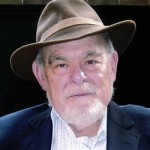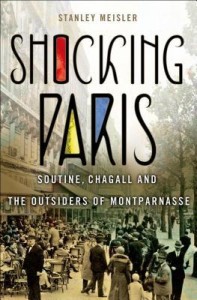Stanley Meisler (HQ Staff 1964-67) publishes SHOCKING PARIS
For a couple of decades before World War II, a group of immigrant painters and sculptors, including Amedeo Modigliani, Marc Chagall, Chaim Soutine and Jules Pascin dominated the new art scene of Montparnasse in Paris. Art critics gave them the name “the School of Paris” to set them apart from the French-born (and less talented) young artists of the period. Modigliani and Chagall eventually attained enormous worldwide popularity, but in those earlier days most School of Paris painters looked on Soutine as their most talented contemporary. Willem de Kooning proclaimed Soutine his favorite painter, and Jackson Pollack hailed him as a major influence.
Soutine arrived in Paris while many painters were experimenting with cubism, but he had no time for trends and fashions; like his art, Soutine was intense, demonic, and fierce. After the defeat of France by Hitler’s Germany, the East European Jewish immigrants who had made their way to France for sanctuary were no longer safe. In constant fear of the French police and the German Gestapo, plagued by poor health and bouts of depression, Soutine was the epitome of the tortured artist. Rich in period detail, Stanley Meisler’s (HQ Staff 1964-67) new book Shocking Paris explores the short, dramatic life of one of the most influential artists of the twentieth century.
In an email about the publication of Shocking Paris:Soutine, Chagall and the Outsiders of Montparnasse, Stan wrote me,
The main theme of the book is laid down in my description of the Paris scene right after World War I. When Doctor Barnes, the wealthy American collector, made his annual shopping trip to Paris in 1922, he decided to concentrate on the works of the young artists there. He returned to Philadelphia with paintings by Amedeo Modigliani, Chaim Soutine, Jules Pascin, Moïse Kisling and sculpture by Jacques Lipchitz and mounted a show to demonstrate what the young artists of Paris were up to. His choices shocked the Paris art establishment. Not a single one of his chosen artists was French-born. All were immigrants, and all were Jewish. I then go on to describe the life and work of Soutine, Chagall and the rest of the foreigners who became known as the School of Paris. World War II brings Vichy, the Nazis, the threat of Auschwitz, and the destruction of the School of Paris.
of the book is laid down in my description of the Paris scene right after World War I. When Doctor Barnes, the wealthy American collector, made his annual shopping trip to Paris in 1922, he decided to concentrate on the works of the young artists there. He returned to Philadelphia with paintings by Amedeo Modigliani, Chaim Soutine, Jules Pascin, Moïse Kisling and sculpture by Jacques Lipchitz and mounted a show to demonstrate what the young artists of Paris were up to. His choices shocked the Paris art establishment. Not a single one of his chosen artists was French-born. All were immigrants, and all were Jewish. I then go on to describe the life and work of Soutine, Chagall and the rest of the foreigners who became known as the School of Paris. World War II brings Vichy, the Nazis, the threat of Auschwitz, and the destruction of the School of Paris.
In recent years, Stan has written the biography Kofi Annan: A Man of Peace in a World of War, the history United Nations: A History (a revised and expanded edition of his earlier United Nations: The First Fifty Years) and When The World Calls: The Inside Story Of The Peace Corps And Its First Fifty Years.
Stan was deputy director of the Office of Evaluation and Research of the U.S. Peace Corps in Washington before joining the Los Angeles Times where he was a foreign and diplomatic correspondent for thirty years, assigned to Nairobi, Mexico City, Madrid, Toronto, Paris, Barcelona, the United Nations and Washington. He still contributes articles to the Los Angeles Times Book Review, Sunday Opinion and Art sections and writes a News Commentary for his website, StanleyMeisler.com.
Congratulations, Stan!
•
Shocking Paris: Soutine, Chagall and the Outsiders of Montparnasse
by Stanley Meisler
Palgrave Macmillan
April 2015
256 pages
$26.00 (hard cover), $12.99 (paperback)

No comments yet.
Add your comment